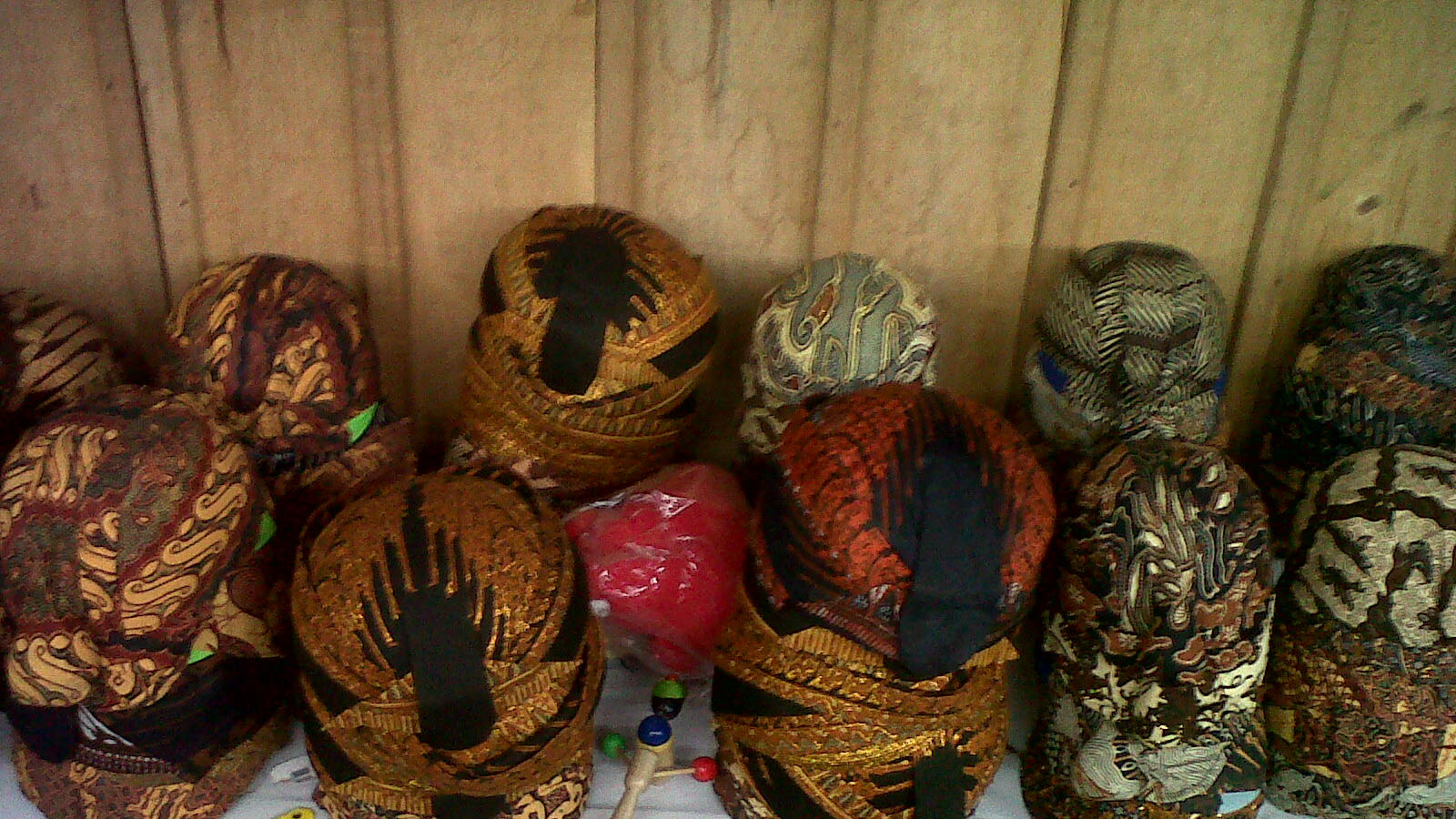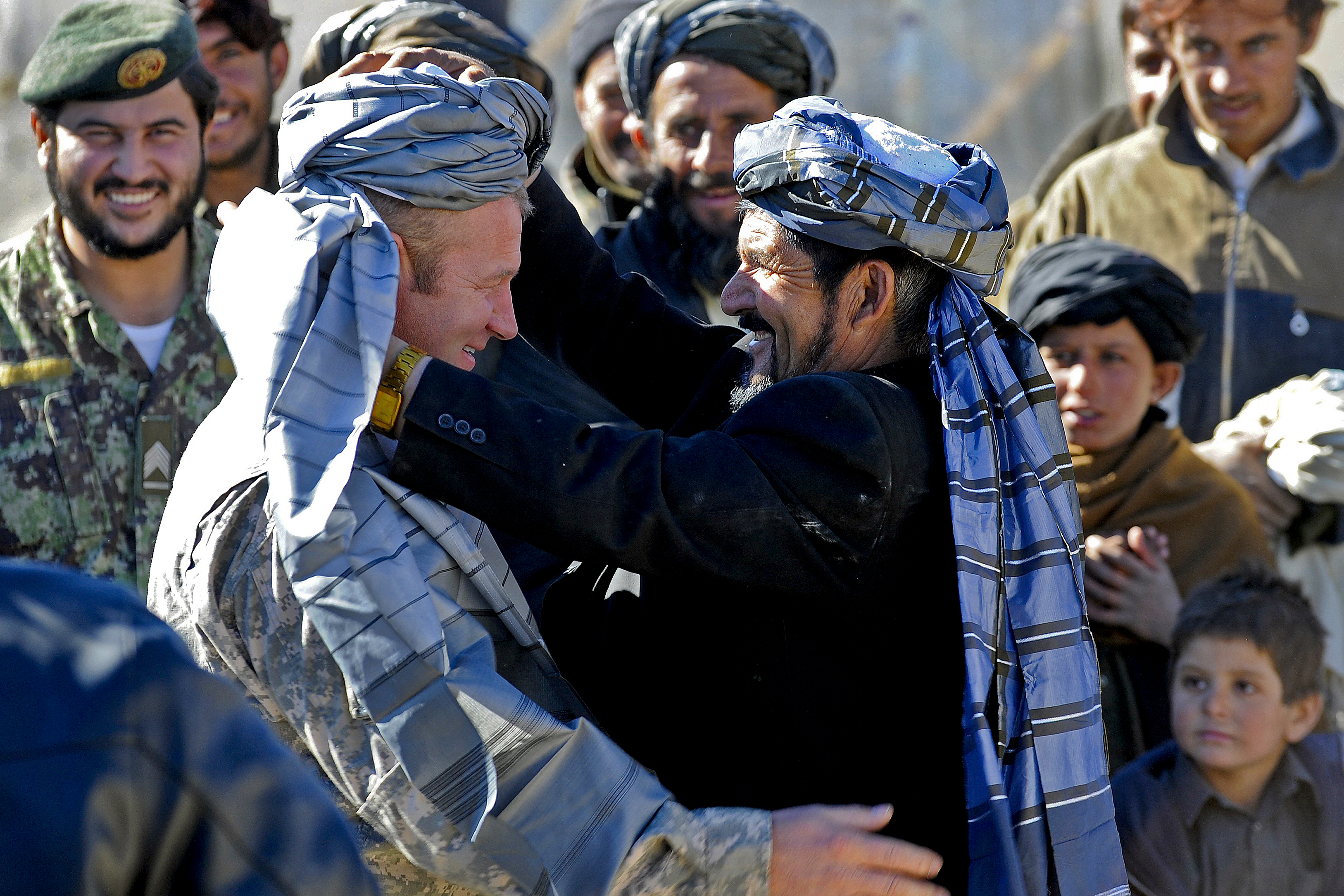|
Blangkon
A blangkon ( Javanese: ) or belangkon (in Indonesian) is a traditional Javanese headgear worn by men and made of batik fabric. There are four types of blangkons, distinguished by the shapes and regional Javanese origin: Ngayogyakarta, Surakarta, Kedu, and Banyumasan. History It is believed that blangkon may be as old as the Javanese script, and inspired from the legendary story of Aji Saka. In the story, Aji Saka defeated Dewata Cengkar, a giant who owned the land of Java, by spreading a giant piece of headdress that could cover the entire land of Java. Aji Saka was also believed to be the founder of the Javanese calendar. Another theory is that the use of blangkon was adopted by the Javanese due to the combined influence of local Hindu and Islamic culture. The Muslim traders who entered Java were people from various places, including mainland Arab and Gujarati regions, and the blangkon is sometimes believed to be adapted from turbans; however, this is unlikely because the ... [...More Info...] [...Related Items...] OR: [Wikipedia] [Google] [Baidu] |
List Of Hat Styles
Hats have been common throughout the history of humanity, present on some of the very earliest preserved human bodies and art. Below is a list of various kinds of contemporary or traditional hat. List See also *List of headgear References External links * Lesa Collection - Cowboy & Western Hats {{DEFAULTSORT:Hat styles Clothing-related lists Hats, ... [...More Info...] [...Related Items...] OR: [Wikipedia] [Google] [Baidu] |
Turban
A turban (from Persian language, Persian دولبند, ''dolband''; via Middle French ''turbant'') is a type of headwear based on cloth winding. Featuring many variations, it is worn as customary headwear by people of various cultures. Communities with prominent turban-wearing traditions can be found in, Punjabis, the Punjabis, the Indian subcontinent, Southeast Asia, the Middle East, the Balkans, the Caucasus, Central Asia, North Africa, West Africa, East Africa, and amongst some Turkic peoples in Russia. A keski is a type of turban Majorly worn by female Sikhs, a long piece of cloth roughly half the length of a traditional "single turban", but not cut and sewn to make a double-width "Double Turban" (or Double Patti). Wearing turbans is common among Sikh men (Dastar), and infrequently women. They are also worn by Hinduism, Hindu monks. The headgear also serves as a religious observance, including among Shia Islam, Shia Muslims, who regard turban-wearing as ''Sunnah mu'akka ... [...More Info...] [...Related Items...] OR: [Wikipedia] [Google] [Baidu] |
Raden Saleh
Raden Saleh Sjarif Boestaman (, EYD: ; , DIN: ; 1811 – 23 April 1880) was a pioneering Romantic painter from the Dutch East Indies of Arab- Javanese ethnicity. He was considered to be the first "modern" artist from Indonesia (then the Dutch East Indies), and his paintings corresponded with nineteenth-century romanticism which was popular in Europe at the time. He also expressed his cultural roots and inventiveness in his work. Early life Raden Saleh Syarif Bustaman was born in 1811 in the village of Terboyo, near Semarang on the island of Java in the Dutch East Indies (present-day Indonesia). He was born into a noble Hadhrami family; his father was Sayyid Husen bin Alwi bin Awal bin Yahya, whose family had come to Java via Surat in India in the seventeenth century. He was the grandson of Sayyid Abdullah Bustam through his mother, Raden Ayu Sarif Husen bin Alwi bin Awal. Through his sister, Roqayah, Raden Saleh was uncle by marriage to the famous religious leader Habib Al ... [...More Info...] [...Related Items...] OR: [Wikipedia] [Google] [Baidu] |
Headgear
Headgear, headwear, or headdress is any element of clothing which is worn on one's Human head, head, including hats, helmets, turbans and many other types. Headgear is worn for many purposes, including protective clothing, protection against the elements, decorative, decoration, or for religious or cultural reasons, including social conventions. Purposes Protection or defence Headgear may be worn for protective clothing, protection against cold (such as the Canadian tuque), heat, rain and other Precipitation (meteorology), precipitation, glare, sunburn, sunstroke, dust, contaminants, etc. Helmets are worn for protection in battle or against impact, for instance when riding bicycles or motor vehicles. Fashion Headgear can be an article of fashion, usually hats, caps or hood (headgear), hoods. The formal man's black silk top hat was formerly an indispensable portion of the suit, and women's hats have, over the years, attained a fantastic number of shapes ranging from immense c ... [...More Info...] [...Related Items...] OR: [Wikipedia] [Google] [Baidu] |
Hinduism In Indonesia
Hinduism is the third-largest religion in Indonesia, based on civil registration data in 2023 from Ministry of Home Affairs, is practised by about 1.68% of the total population, and almost 87% of the population in Bali. Hinduism was the dominant religion in the country before the arrival of Islam and is one of the six official religions of Indonesia today. Hinduism came to Indonesia in the 1st-century through Indian traders, sailors, scholars and priests. A syncretic fusion of pre-existing Javanese folk religion, culture and Hindu ideas, that from the 6th-century also synthesized Buddhist ideas as well, evolved as the Indonesian version of Hinduism. These ideas continued to develop during the Srivijaya and Majapahit empires. About 1400 CE, these kingdoms were introduced to Islam from coast-based Muslim traders, and thereafter Hinduism, which was previously the dominant religion in the region, mostly vanished from many of the islands of Indonesia. Indonesia has the fourth-lar ... [...More Info...] [...Related Items...] OR: [Wikipedia] [Google] [Baidu] |
Tengkolok
''Tengkolok'' ( Jawi: ), also known as ''Tanjak'', ''Destar'' ( Minangkabau: ''Deta''; Kelantan-Pattani: Semutar; Brunei: Dastar) is a traditional Malay or Indonesian (Indonesia) and male headgear. It is made from long songket cloth folded and tied in a particular style (''solek''). Nowadays, it is usually worn in ceremonial functions, such as royal ceremonies by royalties, and wedding ceremonies by grooms. Name The terms ''tengkolok'', ''Tanjak'', and ''setanjak'' are synonyms; the word "tengkolok" also refers to "headgear or headcover worn by women", but the definition of women's headgear is rarely used today. (Indonesian) However, some people say that ''tengkolok'', ''tanjak'', and ''destar'' are different in terms of cloth type or tying even though the purpose is the same, which the tengkolok is a headgear made from cloth of good quality and its tying has many layers and tapers to tip; ''destar'' has low tying and its tying layers are fewer than ''tengkolok''; ''tanjak'' ... [...More Info...] [...Related Items...] OR: [Wikipedia] [Google] [Baidu] |
Pagri (turban)
Pagri, sometimes also transliterated as pagari, is the term for turban used in the Indian subcontinent. It specifically refers to a headdress that is worn by men and women, which needs to be manually tied. Other names include ''sapho''. Cloth A pagri is usually a long plain unstitched cloth. The length may vary according to the type. The cloth indicates the region and the community of the wearer. Specific styles Baul Sufi mystics of Bangladesh, known as ''"Baul Fakirs"'' , can often be identified by their distinctive clothes. Men typically wear long tunics, known as Alkhallah and turbans known as ''"Pagri"''. Women usually wear white Handloom saris, jewelleries, can sometimes also be spotted with turbans. ''khirki-dār-pagari'' Methods of binding the pagri are innumerable, and khirki-dar-pagri is one particular style of dressing the turban. Khirki-dar-pagri means the turban with a window. Brocade piece may decorate the turban. Paag The paag is a headdress in t ... [...More Info...] [...Related Items...] OR: [Wikipedia] [Google] [Baidu] |
Dutch East Indies
The Dutch East Indies, also known as the Netherlands East Indies (; ), was a Dutch Empire, Dutch colony with territory mostly comprising the modern state of Indonesia, which Proclamation of Indonesian Independence, declared independence on 17 August 1945. Following the Indonesian National Revolution, Indonesian War of Independence, Indonesia and the Netherlands Dutch–Indonesian Round Table Conference, made peace in 1949. In the Anglo-Dutch Treaty of 1824, the Dutch ceded the governorate of Dutch Malacca to Britain, leading to its eventual incorporation into Malacca, Malacca (state) of modern Malaysia. The Dutch East Indies was formed from the nationalised Factory (trading post), trading posts of the Dutch East India Company, which came under the administration of the Batavian Republic, Dutch government in 1800. During the 19th century, the Dutch fought Royal Netherlands East Indies Army, many wars against indigenous rulers and peoples, which caused hundreds of thousands of d ... [...More Info...] [...Related Items...] OR: [Wikipedia] [Google] [Baidu] |
Megawati
Diah Permata Megawati Setiawati Sukarnoputri (; born 23 January 1947) is an Indonesian politician who served as the fifth president of Indonesia from 2001 to 2004 and the eighth vice president under President Abdurrahman Wahid from 1999 to 2001. She is Indonesia's first and only female president to date. Megawati Sukarnoputri became president in 2001 when Abdurrahman Wahid was impeached and removed from office. She ran for re-election in the 2004 presidential election, but was defeated by Susilo Bambang Yudhoyono. She ran again against Yudhoyono in the 2009 presidential election, and was defeated a second time. She is the first and current leader of the Indonesian Democratic Party of Struggle (PDI-P), one of Indonesia's largest political parties. She is the eldest daughter of Indonesia's first president, Sukarno. Name Megawati's last name (''Sukarnoputri'', meaning "daughter of Sukarno") is a patronym, not a family name. Javanese often do not have family names, similarly Mi ... [...More Info...] [...Related Items...] OR: [Wikipedia] [Google] [Baidu] |
Kris
The kris or is a Javanese culture, Javanese asymmetrical dagger with a distinctive blade-patterning achieved through alternating laminations of iron and nickelous iron (''pamor''). The kris is famous for its distinctive wavy blade, although many have straight blades as well, and is one of the Weapons of silat, weapons commonly used in the ''pencak silat'' martial art native to Indonesia. Kris have been produced in many regions of Indonesia for centuries, but nowhere—although the island of Bali comes close—is the kris so embedded in a mutually-connected whole of ritual prescriptions and acts, ceremonies, mythical backgrounds and epic poetry as in Central Java. Within Indonesia the kris is commonly associated with Javanese culture, although other ethnicities in it and surrounding regions are familiar with the weapon as part of their cultures, such as the Balinese people, Balinese, Sundanese people, Sundanese, Malays (ethnic group), Malay, Madurese people, Madurese, Banjar peop ... [...More Info...] [...Related Items...] OR: [Wikipedia] [Google] [Baidu] |
Gujarat
Gujarat () is a States of India, state along the Western India, western coast of India. Its coastline of about is the longest in the country, most of which lies on the Kathiawar peninsula. Gujarat is the List of states and union territories of India by area, fifth-largest Indian state by area, covering some ; and the List of states and union territories of India by population, ninth-most populous state, with a population of 60.4 million in 2011. It is bordered by Rajasthan to the northeast, Dadra and Nagar Haveli and Daman and Diu to the south, Maharashtra to the southeast, Madhya Pradesh to the east, and the Arabian Sea and the Pakistani province of Sindh to the west. Gujarat's capital city is Gandhinagar, while its largest city is Ahmedabad. The Gujarati people, Gujaratis are indigenous to the state and their language, Gujarati language, Gujarati, is the state's official language. The state List of Indus Valley civilisation sites#List of Indus Valley sites discovered, ... [...More Info...] [...Related Items...] OR: [Wikipedia] [Google] [Baidu] |








